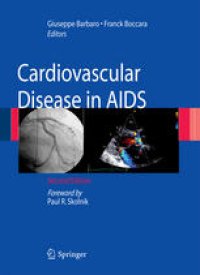
Ebook: Cardiovascular Disease in AIDS
Author: G. Di Perri S. Audagnotto F. Gobbi L. Trentini (auth.) Giuseppe Barbaro Franck Boccara (eds.)
- Tags: Cardiology, Angiology, Infectious Diseases, Internal Medicine
- Year: 2009
- Publisher: Springer-Verlag Mailand
- Edition: 2
- Language: English
- pdf
The introduction of highly active antiretroviral therapy (HAART) has significantly improved the clinical outcome of HIV disease with increased survival rates. However, the introduction of HAART has generated a contrast in the cardiac manifestations of AIDS. In developed countries, we observed an approximate 30% reduction in the prevalence of HIV-associated cardiomyopathy, possibly related to a reduction of opportunistic infections and myocarditis. In developing countries, however, where the availability of HAART is limited and the pathogenic impact of nutritional factors is significant, we observed an approximate 32% increase in the prevalence of HIV-associated cardiomyopathy and a related high mortality rate from congestive heart failure. Additionally, some HAART regimens in developed countries, especially those including protease inhibitors, may cause an iatrogenic metabolic syndrome (HIV-lipodystrophy syndrome) that is associated with an increased risk of cardiovascular disease. At the same time, the relapse of some opportunistic infections, with possible myocardial involvement, in HIV-infected patients receiving HAART, in the context of the recently described immune reconstitution inflammatory syndrome, yielded an intriguing and complex profile of this dual aspect of cardiology in AIDS in the HAART era. In this new edition of Cardiovascular Disease in AIDS, new insights coming from basic and clinical research in the field of HIV-associated cardiovascular disease and antiretroviral therapy are reported, along with the clinical guidelines for a careful stratification of the cardiovascular risk and cardiovascular monitoring of HIV-infected patients receiving HAART. The authors offer a wide overview of the topic for specialists in cardiology and infectious diseases involved in the clinical management of HIV-infected patients.
The introduction of highly active antiretroviral therapy (HAART) has significantly improved the clinical outcome of HIV disease with increased survival rates. However, the introduction of HAART has generated a contrast in the cardiac manifestations of AIDS. In developed countries, we observed an approximate 30% reduction in the prevalence of HIV-associated cardiomyopathy, possibly related to a reduction of opportunistic infections and myocarditis. In developing countries, however, where the availability of HAART is limited and the pathogenic impact of nutritional factors is significant, we observed an approximate 32% increase in the prevalence of HIV-associated cardiomyopathy and a related high mortality rate from congestive heart failure. Additionally, some HAART regimens in developed countries, especially those including protease inhibitors, may cause an iatrogenic metabolic syndrome (HIV-lipodystrophy syndrome) that is associated with an increased risk of cardiovascular disease. At the same time, the relapse of some opportunistic infections, with possible myocardial involvement, in HIV-infected patients receiving HAART, in the context of the recently described immune reconstitution inflammatory syndrome, yielded an intriguing and complex profile of this dual aspect of cardiology in AIDS in the HAART era. In this new edition of Cardiovascular Disease in AIDS, new insights coming from basic and clinical research in the field of HIV-associated cardiovascular disease and antiretroviral therapy are reported, along with the clinical guidelines for a careful stratification of the cardiovascular risk and cardiovascular monitoring of HIV-infected patients receiving HAART. The authors offer a wide overview of the topic for specialists in cardiology and infectious diseases involved in the clinical management of HIV-infected patients.